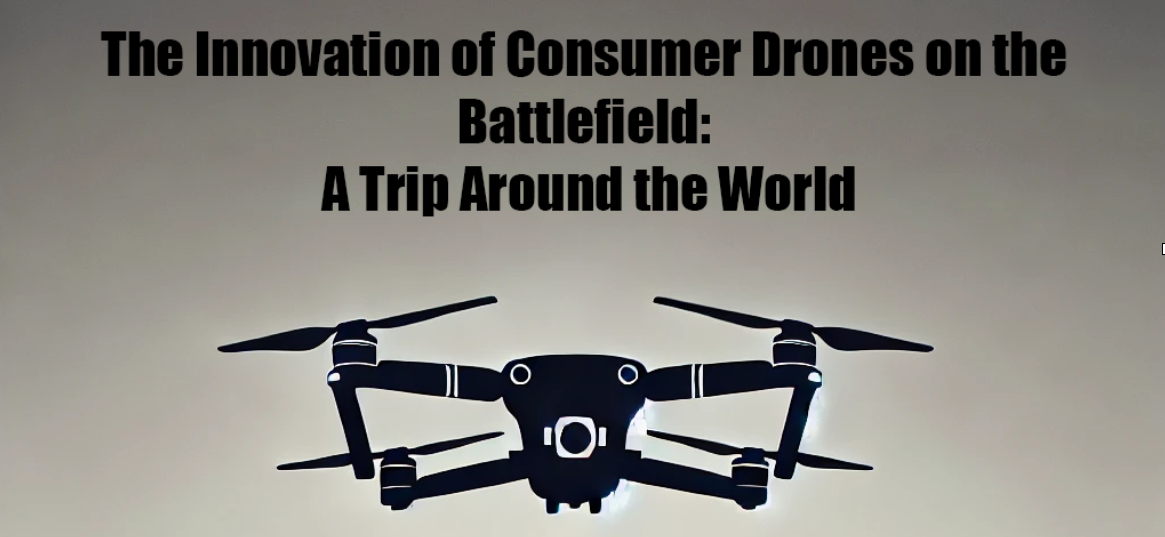By now everyone has seen a ‘first-person view’ (FPV) drone video of a drop of a 40mm explosive, grenade, or other homemade explosive on unsuspecting Russians or Hamas terrorists, or even Ukraine selling ad space on a suicide drone just before it blows the turret off a Russian tank. This evolution in military affairs isn’t likely to slow down anytime soon. Advances in batteries, microchips, lightweight material, and foundational large-language models (LLMs) used to identify targets or navigate without GPS will evolve and diffuse among anyone and any organization willing to weaponize dual-use technology.
Dual-use technology will fuel conflicts and competition alike, with peer adversaries as well as on the fringes – similar to the numerous proxy wars that occurred during the first Cold War. Drones are, and will, play a central role – we need to be ready.
Consumer drones, originally designed for recreational and commercial purposes, are experiencing a revolutionary transformation in military applications. The rapid innovation in American-made drones, particularly in software and foundational models, is redefining battlefield dynamics. This report examines the advancements in drone technology, the pivotal role of software innovation, and its implications in casualty care, logistics, precision munitions, and surveillance.
Software and Foundational Models: The Core of Innovation
The transformative power of consumer drones lies in their software capabilities. Foundational models, powered by artificial intelligence (AI) and machine learning (ML), enable drones to perform highly complex tasks with minimal human intervention. Key innovations include:
- Autonomous Navigation: AI-driven algorithms allow drones to navigate rugged terrains and hostile environments without GPS, using computer vision and sensor fusion.
- Target Recognition: Advanced ML models enhance drones’ ability to identify, track, and classify targets in real-time, improving mission precision.
- Collaborative Swarming: Drones equipped with AI can operate in swarms, communicating with one another to execute coordinated maneuvers for surveillance or attack.
- Adaptive Learning: Foundational models enable drones to learn and adapt to new threats, enhancing their efficacy in dynamic battlefield scenarios.
American-Made Drones: Pioneering Innovation
American companies are at the forefront of integrating cutting-edge technology into consumer drones for military purposes. Manufacturers such as Skydio, Teal Drones, Firestorm, and Shield AI are developing drones that emphasize autonomy, durability, and modularity. These drones are lightweight, portable, and capable of carrying mission-specific payloads, making them ideal for versatile military operations.
In particular, the adoption of open-source and scalable architectures enables seamless integration with existing defense systems, ensuring that American-made drones remain interoperable across various branches of the military.
Taiwan’s Drone Defense Industrial Base
Taiwan is actively building a robust defense industrial base focused on drones and counter-drone technology to address the growing threat from China’s massive scaling capabilities. Inspired by the use of drones in Ukraine, Taiwan aims to develop a fleet of small, cost-effective drones tailored for defensive purposes. China now possesses the world’s largest navy, risking a massive blockade or deployment of low-cost, attritable drones to wreak destruction on the island. Geography prevents Taiwan from replicating Ukraine’s massive, new domestically produced drones and supply chains.
To achieve this, Taiwan is investing in domestic production capabilities to reduce reliance on foreign suppliers, particularly China. This move ensures the security and reliability of its equipment. Counter-drone technology is also a priority, with systems designed to detect, jam, and neutralize incoming threats from enemy drones. Taiwan, using Ukrainian tactics as a framework, is working with private industry partners to build a ‘national drone team’ centered in a research and development park in the city of Chiayi.
These initiatives are critical as Taiwan faces the challenge of defending against China’s extensive drone capabilities, which include swarms and advanced surveillance systems. By focusing on self-reliance and innovation, Taiwan is positioning itself to effectively counterbalance this technological and numerical superiority. DJI, the Chinese drone maker, dominates the sector with three-quarters of the global consumer drone market. Taiwan’s problem is not a technical one, it’s scalability.
The United States currently has a $19.7 billion backlog of arms sales to Taiwan, including $600 million for MQ-9 unmanned drones. This is a good start to counter Chinese drone aggression. The American private sector should begin manufacturing and stockpiling drone components for ourselves and allied nations.
Ukraine’s Innovative Drone Industry
Ukraine has rapidly developed a robust and innovative drone industry to meet the demands of the ongoing conflict with Russia. Ukraine reportedly loses more than 10,000 drones a month to Russia, while Russia can either produce or procure around 100,000 drones per month. Ukrainian officials were tight-lipped about how much production increased in 2024, but Ukraine was on track to produce more than 1.2 million drones by the end of last year, highlighting the scale and intensity of their operations. To sustain this pace, Ukraine has fostered a domestic industry capable of producing and adapting consumer drones for military use with more than 200 Ukrainian companies in-country.
This burgeoning industry focuses on affordability, adaptability, and rapid production. Ukrainian engineers and manufacturers are modifying commercial off-the-shelf drones – both inside and out – to carry out reconnaissance missions, deliver small payloads, and even execute kamikaze attacks. Ukraine is, rightfully so, skeptical of foreign drone manufacturers, even the United States. Myriad companies have rushed to Ukraine to test their equipment in the hopes of landing a deal with Ukraine or any allied benefactors, but almost all of them have fallen short. Shield AI, a San Diego-based company founded by a former Navy SEAL, has notched a rare win recently with the use of the V-BAT and its ability to operate without the use of GPS, making it harder to jam with Russia’s electronic warfare. The V-BAT can fly without GPS using AI software empowered by onboard Nvidia chips. Mapping terrain, storing static maps onboard, and training the systems are capabilities that battlefields around the world will see in the near future.
Ukraine’s experience underscores the critical role that innovation and agility play in modern warfare. By leveraging its domestic talent and resources, Ukraine has transformed drones into essential tools for frontline operations, providing a model for other nations facing similar challenges. The United States and her allies must heed the warnings from the frontlines: innovation is not some buzzy catchphrase for bureaucrats in the Pentagon and the halls of Congress, it is a rapid cycle of hours to weeks of creative destruction in between hide sites and small, forward factories going head-to-head with Russia every day of the week.
Cost Dynamics: Drones vs. Missiles
The rising prevalence of drones in warfare has highlighted a significant cost mismatch between drones and traditional missile systems. Consumer-grade drones, which can cost as little as a few hundred dollars, are being used to effectively counter multi-million-dollar missile systems. This cost disparity puts nations like the United States in a precarious position, as adversaries leverage inexpensive drones to exhaust expensive defensive resources. This asymmetry not only strains financial resources but also exposes vulnerabilities in traditional military strategies reliant on costly missile defense systems.
Adversaries such as Iran and its proxies have capitalized on this dynamic by deploying swarms of inexpensive drones to overwhelm defenses. These tactics demonstrate how low-cost drones can neutralize expensive and advanced technologies, forcing a reevaluation of defense priorities. The Houthis, an Iranian proxy group, occupy a strategic coastline along Yemen’s western border. The Bab al-Mandab (often referred to as ‘the BAM’) Strait is approximately 13 miles across at the longest point between the Yemeni island Mayyun and Djibouti, Africa. In 2023, 8.7 million barrels a day of oil transited through the BAM. After the Houthi’s drone attacks on both commercial tankers and US Naval vessels, oil shipments fell by more than half, to 4 million barrels a day in 2024. In addition to the large percentage of global oil supply, approximately 30% of oil and 40% of dry goods are transported through the BAM from the Suez Canal and the Red Sea.
Shipping costs increased as well – since the Hamas attacks in October of 2023 and continued attacks by Houthi drones, the cost of a shipping container from China to Europe increased to more than $4,700 from less than $1,000. The Houthis have capitalized on cost mismatches – while headlines will say the Houthis targeted US Naval vessels, the real cost is to the US defense budget. The Houthis used low-cost, public information and open-source intelligence (OSINT) to send a $2,000 drone towards a US Naval destroyer, and the destroyer responded with a $2 million cruise missile. This cost offset is not advantageous for developed nations.
Caitlin Lee, director of RAND’s Acquisition and Technology Policy Program, responded to a February 2024 attack in Jordan that killed three American Servicemembers and wounded dozens more, stating, “This incident is absolutely not a fluke. U.S. military personnel and infrastructure — both abroad and at home — are going to be exposed to drone attacks, and we can expect the sophistication of the technology and tactics to increase.”
The United States must invest in scalable counter-drone systems to mitigate threats without exacerbating the cost imbalance. Solutions such as directed energy weapons, electronic warfare systems, and affordable interceptor drones are being explored to address this growing challenge.
The Threat Comes Home
President Trump’s recent designation of drug cartels as Foreign Terrorist Organizations (FTOs) will have far-reaching implications. FTO designation comes with a wave of expanded military and financial authorities to combat the lethal flow of drugs into the United States. We can expect various forms of domestic blowback from the cartels – including the expanded use of lethal drones in the United States. In a July 2024 Congressional Hearing, Carl Landrum testified:
“At present along our international borders, the Border Patrol maintains only basic C-UAS capability, using only decoding RF methodology to detect, track and identify (DTI), from only a single manufacturer, DJI. For context, Dedrone maintains a library of over 150 unique drone manufacturers, from our deployments around the world. Additionally, even with just this basic DTI capability deployed along our international borders, there have been approximately 37,423 flights detected near the border (within 400 meters) in FY2024 year-to-date (YTD), of which >2,492 of those drones flew illegally across the border.”
Dual-use drones in the United States can be weaponized just as they are in Ukraine, Israel, and Mexico. Drones are already being used in American prisons to drop contraband cell phones, drugs, and other illicit material. The United States must be ready for the threat of drones to come to the homeland.
More on How Drones are Revolutionizing Military Affairs
Casualty Care:
Drones are transforming battlefield medicine by serving as first responders. Equipped with medical supplies and AI-powered diagnostics, they can:
- Evacuate casualties as seen in Ukraine, while other drone companies are developing more complex drones better suited for casualty evacuation (CASEVAC)
- Deliver emergency kits to wounded soldiers in inaccessible areas.
- Provide real-time video feeds to medics, enabling remote triage.
- Transport critical medical equipment or even injured personnel via specialized drones.
Logistics:
Consumer drones are reshaping military logistics by streamlining supply chain operations. They can:
- Deliver ammunition, food, and other supplies directly to frontline troops.
- Reduce dependency on vulnerable ground transport.
- Operate in all weather conditions, ensuring consistent supply delivery.
Precision Munitions:
Advancements in drone-guided weaponry are enhancing strike precision and reducing collateral damage. AI-driven targeting systems enable drones to:
- Pinpoint enemy positions with unmatched accuracy.
- Deploy miniaturized precision munitions, making them cost-effective and deadly.
- Execute decapitation strikes with minimal risk to friendly forces.
Surveillance:
Drones equipped with advanced sensors and AI capabilities are redefining battlefield intelligence. They can:
- Conduct continuous surveillance over vast areas.
- Identify potential threats using real-time data analysis.
- Share intelligence across units, enhancing situational awareness.
Drones Transforming Modern Warfare
The technological revolution of drones on battlefields, particularly in Ukraine, is reshaping modern warfare. Key aspects of this transformation include:
- Accessibility: The availability of low-cost drones has democratized warfare, allowing smaller nations and non-state actors to deploy sophisticated technologies.
- Adaptation: Drones are being used in innovative ways, from precision strikes to reconnaissance and electronic warfare. Ukrainian forces, for example, have adapted commercial drones to disrupt Russian supply lines and provide real-time intelligence.
- Scalability: Drone swarms are becoming a game-changer, overwhelming traditional defenses with sheer numbers. These swarms leverage AI for coordinated attacks, making them highly effective.
- Electronic Warfare Integration: Modern drones are increasingly resistant to jamming and electronic countermeasures, ensuring their effectiveness in contested environments.
- Asymmetric Advantage: Drones give smaller forces a significant edge by enabling them to challenge larger, better-equipped militaries through unconventional strategies.
These advancements illustrate the profound impact of drones on modern warfare, making them a pivotal element in contemporary military strategy.
Challenges and Ethical Considerations
Despite their advantages, the militarization of consumer drones raises challenges:
- Cybersecurity Risks: Drones’ reliance on software makes them vulnerable to hacking and electronic warfare.
- Ethical Concerns: Autonomous drones with lethal capabilities pose moral and legal questions about accountability.
- Operational Limitations: Harsh weather and electromagnetic interference can affect drone performance.
Addressing these issues requires robust policy frameworks and continued investment in resilient technologies.
Written by David Cook
Executive Director





